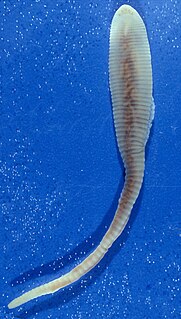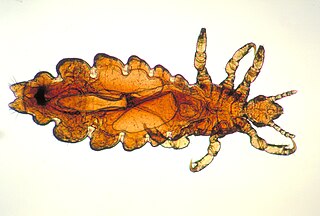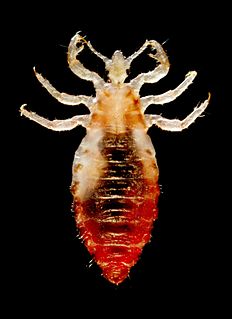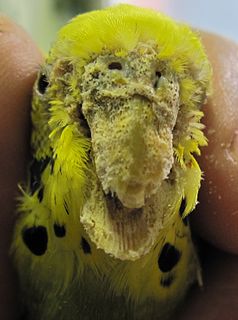 W
WDemodicosis, also called demodectic mange or red mange, is caused by a sensitivity to and overpopulation of Demodex spp. as the host's immune system is unable to keep the mites under control.
 W
WHouse dust mites are mites found in association with dust in dwellings. They are known for causing an allergy.
 W
WLinguatulosis is a condition associated with the organism Linguatula serrata.
 W
WMange is a type of skin disease caused by parasitic mites. Because mites also infect plants, birds, and reptiles, the term "mange" or colloquially "the mange", suggesting poor condition of the hairy coat due to the infection, is sometimes reserved only for pathological mite-infestation of nonhuman mammals. Thus, mange includes mite-associated skin disease in domestic animals, in livestock, and in wild animals. Since mites belong to the arachnid subclass Acari, another term for mite infestation is acariasis.
 W
WMyiasis is the parasitic infestation of the body of a live animal by fly larvae (maggots) which grow inside the host while feeding on its tissue. Although flies are most commonly attracted to open wounds and urine- or feces-soaked fur, some species can create an infestation even on unbroken skin and have been known to use moist soil and non-myiatic flies as vector agents for their parasitic larvae.
 W
WPediculosis is an infestation of lice. The condition can occur in almost any species of warm-blooded animal, including humans. Although pediculosis in humans may properly refer to lice infestation of any part of the body, the term is sometimes used loosely to refer to pediculosis capitis, the infestation of the human head with the specific head louse.
 W
WHead lice infestation, also known as pediculosis capitis, is the infection of the head hair and scalp by the head louse. Itching from lice bites is common. During a person's first infection, the itch may not develop for up to six weeks. If a person is infected again, symptoms may begin much more quickly. The itch may cause problems with sleeping. Generally, however, it is not a serious condition. While head lice appear to spread some other diseases in Africa, they do not appear to do so in Europe or North America.
 W
WPediculosis corporis is a cutaneous condition caused by body lice that lay their eggs in the seams of clothing.
 W
WScabies is a contagious skin infestation by the mite Sarcoptes scabiei. The most common symptoms are severe itchiness and a pimple-like rash. Occasionally, tiny burrows may appear on the skin. In a first-ever infection, the infected person will usually develop symptoms within two to six weeks. During a second infection, symptoms may begin within 24 hours. These symptoms can be present across most of the body or just certain areas such as the wrists, between fingers, or along the waistline. The head may be affected, but this is typically only in young children. The itch is often worse at night. Scratching may cause skin breakdown and an additional bacterial infection in the skin.
 W
WScaly foot, or knemidocoptiasis is a bird ailment that is common among caged birds and also affects many other bird species. It is caused by mites in the genus Knemidocoptes which burrow into the bird's flesh. The tunnels made by the mites within the skin cause dermatitis and scaly lesions. Scaly face is caused by the same mite responsible for scaly foot and other related mites cause depluming. The condition is transmitted from one bird to another by direct prolonged contact.
 W
WTrombiculosis, is a rash caused by trombiculid which is often referred to as a chigger bite.
 W
WTungiasis is an inflammatory skin disease caused by infection with the female ectoparasitic Tunga penetrans, found in the tropical parts of Africa, the Caribbean, Central and South America, and India. Tunga penetrans is the smallest known flea, measuring 1 mm across. It is also known in Latin America as the nigua and bicho de pie (Spanish) or bicho de pé (Portuguese), literally "foot bug". Tunga penetrans is a member of the genus Tunga, which comprises 13 species.